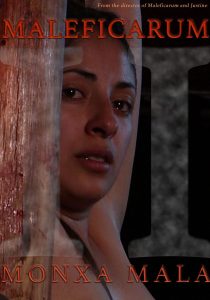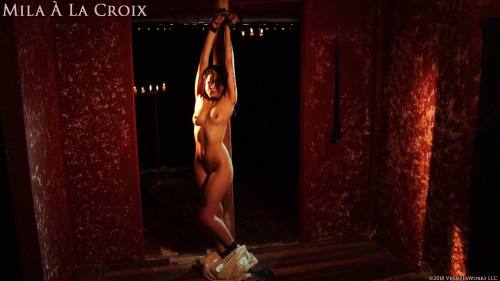by Rich Moreland, July 2019
In this installment of Monxa Mala, we’ll offer our analysis of the story. We’re getting literary here so to fully appreciate the visual impact of this drama, purchase the film from Vermeerworks.
Photos are courtesy of Pachamama/Decadent Films and Jac Avila.
* * *
Each woman in Maleficarum II: Monxa Mala is adept at self-preservation. Martina and Justa do it through silence. Barbara and Lucrecia use their sexuality. Both women identify with their abuser and become Enforcers to avoid the painful end of the whip.
Julia wants to please and coincidentally relishes her punishments meted out by the Father. Essentially, she’s a cultist who symbolizes the faithful sheep (worshipers) who never question. However, her allegiance also has a darker side. Julia is symbolic of both parties in the age-old struggle between the Church and the forces of Satan because she’s willing to dance with the Father, however he is disguised.
Leticia is an independent spirit and the Father is determined to crush her individuality, vowing to “expel those demons that mortify you.” Shackled and awaiting her chastisement, Leticia endures his sanctimonious judgment of her “transgressions” . . . reckless, conceited, proud, arrogant, defiant, unruly . . . just for a start.
As Leticia grimaces under the lash wielded by Lucrecia, the Father calmly tells her, “You are Eve. God’s sentence hangs over all your sex.”
It’s an age-old, time-worn accusation. If left to their own designs, women will disgrace and dishonor the Church. Their curse is the sexual urges they arouse in men, an intolerable situation that calls for action. The best way to stamp out carnal desire, according to the Father’s logic, is to act on it first and then delight in its destruction. In other words, discipline the messenger before disposing of her in a righteous way.
“The cross is a noble punishment,” the Father declares.
The Father sees women as pawns. As God’s representative, he is unsullied, giving him free rein to debase the novices for his personal gratification before justifiably torturing them. We see that with Barbara’s “problem.” It’s taken care of on the rack after she whispers that she might be carrying something of his.
Alive
Leticia’s single-mindedness and her strength are brought to light in the bedchamber where ointment is applied after her scourging. She says with grit, “I will leave this place . . . maybe broken up into pieces, but I’ll leave from here alive.”
Leticia’s pronouncement reverberates through the film as each novice/nun seeks a way to ameliorate her own situation.
The challenge for the viewer is to interpret what “leave alive” means. Is Jac Avila telling us that faith conquers death? Internal strength survives the pain of torture? Church oppression is never final?
Or, is Leticia offering us an undeniable feminist statement, thus transforming Monxa Mala into a feminist film? In other words, is paganism pro-woman because it flies in the face of Church patriarchy?
After all, some nuns get what they want, don’t they. . . ? Which brings us to the malleable Julia.
A Tidy Little Masochist
Julia is central to the film if one considers it to be a sadomasochistic horror tale with enough whipped backs and boobs to fascinate dedicated BDSMers. The novice is itching for her punishments and can mete out a bit of sadistic pleasure herself.
She uses the Father, seducing him in ways she knows will work. Julia confesses she is “a great sinner” who has “sinful thoughts about your Grace.” She fawns at his feet and extracts a kiss from him. The perfect toady. Important because another novice, the whipped Barbara, ends up on the wheel . . .
. . . and Lucrecia will endure the collar, then the rack.
By the way, when he kisses Julia, the Father pulls down her garment to bare her breasts, triggering her sexual excitement.
Julia’s conflation of pain and sex is well noted in the film. When Leticia’s bloody marks are being treated, Julia says, “Did it hurt very much?” Leticia replies, “You would have loved it.”
Later as Julia is being lashed by Barbara’s hand, Leticia walks in and watches with a half-smile. Julia closes her eyes in ecstasy and hardly flinches.
“Your dream becomes reality,” Leticia says with a degree of sarcasm.
“I’m doing my penance with humility,” Julia says softly, “but I don’t feel the pain.” She smiles with smug superiority.
Who is being manipulated here?
Julia is the masochistic delight of Monxa Mala so don’t miss her whipping scene on the ladder. She is arrogant in her own way when she says to the Father that it’s her turn “with the flagellum.” “My wish is to be whipped by your grace,” she declares, so there are no shackles or restraints. This is Julia’s fun and she gets another kiss for her submission.
The scene is back side/front side and a naked Stephanie Vargas is eye candy. We hope to see her in future films.
Beyond the Red Feline series, rarely has the Pachamama/Decadent library captured a better pure masochist on film.
By the way, Julia is a switch of sorts. Using the needle probe, she increases Leticia’s agony when she gets the chance. Just goes to show you that pain lovers can be feisty if the opportunity rises. The needle has a deeper meaning, however. Julia’s fascination with it is a thinly veiled comment on her own raging need for penetration of another sort.
Oh yes, there is something else this moment reveals. Competition and revenge festers among the women. During Julia’s earlier whipping, Leticia pokes her in the ribs with a nail used in crucifixion. Turnabout is fair play, is it not?
Various Sides of a Woman
Writer/director Jac Avila leaves the viewer to decide what the Father means when he references the “big lie” that is making its way around the monastery.
No matter how such a lie is interpreted, remember that each novice/nun in Monxa Mala represents a side of the human condition that is tested by it. Leticia is the rebel who is unrepentant while Julia is the cultist who refuses to question. Barbara is sexual lust and power personified, the opposite of Lucrecia whose pragmatism guides her actions.
Martina and Justa represent the old adage, “the less said, the better.” In Martina’s case, she solves problems. We see that when talk with the Father turns to performing abortions to rid the monastery of its recurring unspoken “problem.” Lucrecia volunteered for one, Martina informs us.
It’s the big coverup that gets out of control. Except for Leticia who remains defiant and pays with a crown of thorns, the women have sold their souls to the Devil in a bargain driven by necessity. They have forfeited their choices.
Throughout the film, the tension between the Father and Leticia becomes a psychological tug-of-war. He threatens, she resists. As the story moves into its later stages, Leticia becomes the omnipotent power of freedom that sees everything for what it is.
In the final scenes, only the Enforcers, Lucrecia and Barbara, remain on-screen. They are crucified and the Father penetrates them once again, this time symbolically with the needle probe.
Finally the stage is empty of its victims. The Father sits calmly, pleased with his cleansing of the holy order. The Church is left naked and alone to wallow in its self-righteousness, or so it seems because there is more to this ending.
Some Final Comments
Unlike previous Jac Avila films, there is not much total nudity in Monxa Mala. For some viewers, this will be disappointing.
Only Barbara and Julia get down to complete exposure. The others rely on loin cloths when the action gets rough. From my experience writing in the film industry, directors rarely push actresses to nudity if they are not amenable to that. Respecting boundaries is paramount.
If you are a fan of a girl bound and bare, watch the scenes with Barbara on the wheel . . .
. . . and Julia on the ladder. They are worth the price of the film.
By the way, Daniela Borda and Simonne de la Riva are stars in the making. Both are “hot,” to use a sexually charged term, and their acting is quite good. Daniela has an earthiness and Simonne an air of sophistication that offer contrasting interpretations of what BDSM sexuality is about. Here’s hoping for more of both soon.
Also, Graciela Tamayo and Inces Copa represent a counter-balance to the Father’s debauchery. They are guiding figures whose presence reminds to viewer of the goodness that the Church offers.
As for Mila Joya, this reviewer admits he has an enduring affection for her portrayal of tortured victims in Pachamama/Decadent Films. She has a rich and sensuous resume to her name.
Mila is superb with a quiet, gentle demeanor and a willingness to suffer for her art. Not only is this demure sweetheart talented, but she fills the screen with a body to die for.
Don’t take my word for Mila’s commanding presence on-screen. Check out two previous Jac Avila films that feature her solitary suffering in the chamber of pain. They are Le Marquis de la Croix (reviewed on this blog: April 29-May 5, 2017) and her newest offering, Mila a la Croix.
In conclusion, no commentary on a Pachamama/Decadent production is complete without a final mention of Amy Hesketh. As referenced in Part One, she’s not cast in this film but her presence is evident in the story. And, of course, the whipping scenes carry her stamp. Amy is the standard for the visual feast that is Monxa Mala and deserves a special nod from all of us.
* * *
After rigorous filming and lots of “torture,” the cast enjoys a well-deserved party. Congratulations on a cool and entertaining production!





























